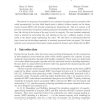Free Online Productivity Tools
i2Speak
i2Symbol
i2OCR
iTex2Img
iWeb2Print
iWeb2Shot
i2Type
iPdf2Split
iPdf2Merge
i2Bopomofo
i2Arabic
i2Style
i2Image
i2PDF
iLatex2Rtf
Sci2ools
CORR
2004
Springer
2004
Springer
Bounds on the decoding complexity of punctured codes on graphs
We present two sequences of ensembles of non-systematic irregular repeat-accumulate codes which asymptotically (as their block length tends to infinity) achieve capacity on the binary erasure channel (BEC) with bounded complexity per information bit. This is in contrast to all previous constructions of capacity-achieving sequences of ensembles whose complexity grows at least like the log of the inverse of the gap (in rate) to capacity. The new bounded complexity result is achieved by puncturing bits, and allowing in this way a sufficient number of state nodes in the Tanner graph representing the codes. We also derive an information-theoretic lower bound on the decoding complexity of randomly punctured codes on graphs. The bound holds for every memoryless binary-input output-symmetric channel, and is refined for the BEC.
| Added | 17 Dec 2010 |
| Updated | 17 Dec 2010 |
| Type | Journal |
| Year | 2004 |
| Where | CORR |
| Authors | Henry D. Pfister, Igal Sason, Rüdiger L. Urbanke |
Comments (0)

